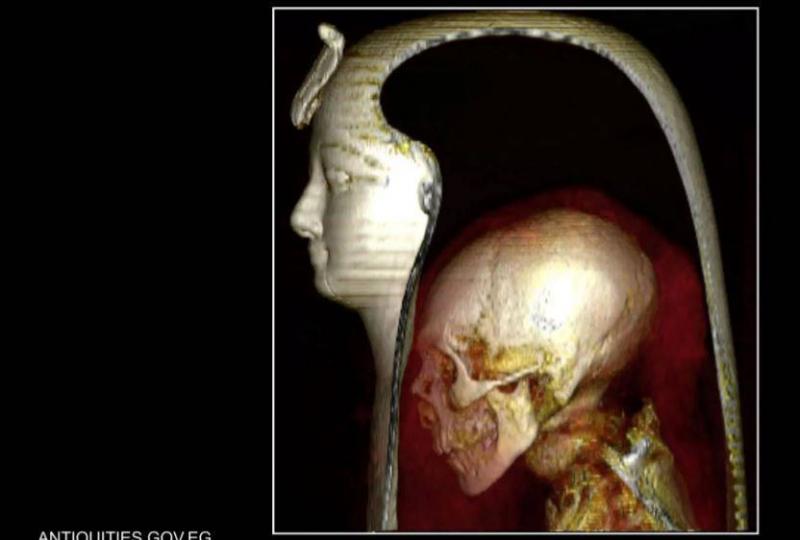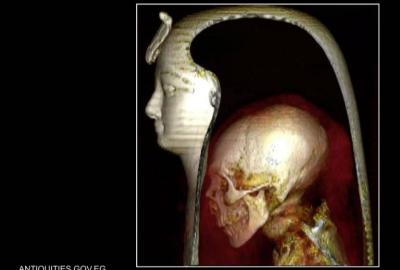After years of mystery surrounding the mummy of the great Egyptian king Amenhotep I, new details about his life are emerging thanks to a recent study that unveiled secrets of the royal mummy, published on Tuesday in the journal "Frontiers in Medicine." For nearly 30 centuries, Amenhotep I's mummy remained in its enchanting state; wrapped in linen and adorned from head to toe with wreaths of red, yellow, and blue flowers, while the head was covered with a mask made of painted wood and cartonnage.
Since its discovery in 1881 in a hiding place in the royal Deir el-Bahari in Luxor, Amenhotep I's mummy has passed through several phases, initially preserved in the Bulaq Museum, later moved to Ismail Pasha's palace in Giza, and in 1902 transferred along with other royal mummies to the Egyptian Museum in Tahrir, Cairo. The mummy has undergone several studies since its discovery; due to its beautiful appearance, it was among a few mummies that modern scientists never unwrapped. Among the research conducted was X-ray imaging in 1932 by Douglas Derry, a professor at Qasr Al-Ainy Medical School in Cairo, who estimated Amenhotep I's age at death to be between 40 and 50 years.
In 1967, a Michigan University expedition X-rayed Amenhotep I's mummy, estimating his age at about 25 years, based on the good condition of the teeth. All these estimates regarding Amenhotep I's age were unsatisfactory, as the "two-dimensional" X-rays did not accurately reveal the secrets of the mummy, until recently, when Egyptian scientists Zahi Hawass, an Egyptologist and former Minister of Antiquities, and Dr. Sahar Saleem, a diagnostic radiology professor at Cairo University, decided to examine the mummy using computed tomography (CT).
**Secrets of a Great King**
In early May 2019, Sahar Saleem was poised to receive a gift from the heavens when she started conducting CT scans on Amenhotep I's mummy, being the first to see the face of the Egyptian king after being reburied nearly 3000 years ago. The diagnostic radiology professor described her feelings during the initial moments of uncovering the secrets of the mummy of Amenhotep I, who is considered one of the greatest kings of ancient Egypt.
According to Saleem and Hawass's study, Amenhotep I ruled Egypt for 21 years (around 1525-1504 BC), being the second king of the Eighteenth Dynasty after his father Ahmose I, with his name meaning "Amun is satisfied." Amenhotep I's reign was marked by prosperity and peace; he protected Egypt’s territories, led a campaign to Kush, and conducted an exploratory expedition to Libya. He constructed many temples, including the Temple of Amun in Karnak, and shrines in Upper Egypt at Elephantine, Kom Ombo, and Abydos. After his death, Amenhotep I and his mother were worshipped in the Valley of the Kings.
**What’s New?**
Despite previous X-ray examinations of Amenhotep I's mummy, the CT scans revealed new details. The X-rays were unable to provide consistent information about the mummy, as three-dimensional data appeared on two-dimensional X-ray films, resulting in an overlay of the mummy's components that compromised accurate description. However, with CT imaging, scientists were able to peel away hundreds of thin layers of the body, providing more detailed reconstructions of soft tissues and bones.
Saleem revealed to Sky News Arabia the secrets of the mummy following the CT scan, stating that one of the most important findings was that Amenhotep I's health was good, and his age at death was estimated to be 35 years, as inferred from the meeting point of his pelvic bones. The examination showed that Amenhotep I was approximately 169 cm tall, circumcised, had well-maintained teeth, and wore 30 amulets, surrounded by a belt consisting of 34 golden beads connected to an amulet in the shape of a shell.
Regarding the cause of death, she indicated that no reason for an unnatural death was found in the mummy; there were no injuries or diseases affecting the bones, nor were there signs of arteriosclerosis as seen in other mummies. It is suggested that death may have occurred due to infection or injury to any organ removed during mummification. She clarified that the CT scan cannot reveal the cause of death unless there are signs in the bones or tissues, unlike the decapitation marks on the neck of Ramses III, the amputation observed on his left toe, or the facial wounds on the mummy of Seqenenre Tao, and also the fracture detected on Tutankhamun's leg.
Saleem mentioned that the scans showed a strong resemblance between Amenhotep I and his father King Ahmose; the mummy’s face exhibits narrow chin features, a small narrow nose, curly hair, and slightly protruding upper teeth. She pointed out that the mummy's condition indicates it received meticulous care after being reburied by the priests of the Twenty-First Dynasty in the royal Deir el-Bahari cache, with more than one section repaired on the mummy resulting from the actions of royal tomb robbers. Saleem considers this behavior by the priests to be one of the best signs indicating a high cultural dimension.
**Restoration of Honor**
In commenting on the study's findings, Zahi Hawass explained that one of the significant points revealed is that this mummy is the first to be mummified in the Osirian way (with the arms crossed). This practice persisted with all the kings of the New Kingdom. Hawass added to Sky News Arabia that the study restores the honor of the priests of the Twenty-First and Twenty-Second Dynasties, who have often been accused by archaeologists of stealing the jewelry of the mummies after they were moved to the Deir el-Bahari; the presence of jewelry in Amenhotep I's mummy disproves this theory and confirms that the priests transferred the mummies to preserve them.
The Egyptologist clarified that he, along with Dr. Sahar Saleem, studied 40 mummies as part of the Royal Mummy Project initiated by the Ministry of Tourism and Antiquities in 2005, gathering much information about these mummies, but he emphasized that the study of Amenhotep I's mummy is one of the most important research projects conducted in this regard.




